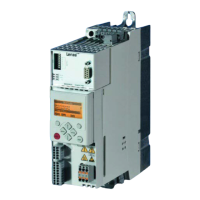8400 StateLine C | Reference manual
Motor control (MCTRL)
Parameterisable additional functions
200 L Firmware ≤ 11.00 - DMS 8.0 EN - 10/2011
5.9.4 Flying restart function
The flying restart circuit for asynchronous motors uses a simple motor model which
requires knowledge of the motor stator resistance RS and the rated motor current.
Tip!
In association with the flying restart function, we recommend information
provided in this documentation on the following topic:
Automatic DC-injection braking (auto DCB)
( 204)
General information
This function serves to activate a mode which is used to "catch" a coasting motor during
operation without speed feedback. This means that the synchronicity between controller
and motor is to be adjusted in such a way that a jerk-free transition to the rotating
machines is achieved in the instant of connection.
The drive controller determines the synchronicity by identifying the synchronous field
frequency.
Note!
• Currently, the flying restart circuit is only available for asynchronous motors.
(A flying restart circuit for synchronous motors is in preparation.)
• For a correct functioning of the flying restart circuit, we recommend to
perform a parameter identification first. Automatic motor data
identification ( 112)
• The flying restart function works safely and reliably for drives with great
centrifugal masses.
• Do not use the flying restart function if several motors with different
centrifugal masses are connected to a controller.
• After the controller is enabled, the motor can start for a short time or reverse
when machines with low friction and low mass inertia are used.
• The flying restart function serves to identify max. field frequencies up to
±200 Hz.
• When power-adapted standard asynchronous motors are used (rated motor
power approximately corresponds to the rated inverter power), a motor
parameter identification is not required.
• On drive systems with feedback, you do not need to use the flying restart
function because the synchronisation to the speed detected by the feedback
is always carried out in a jerk-free manner.

